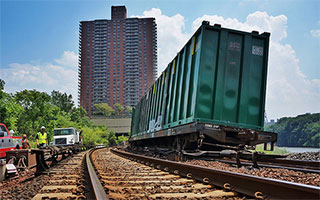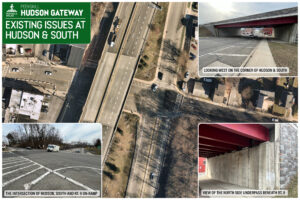 Four days after a major freight derailment, Metro-North tonight continued recovery efforts in anticipation of a normal AM Peak Service on its Hudson Line on Monday.
Four days after a major freight derailment, Metro-North tonight continued recovery efforts in anticipation of a normal AM Peak Service on its Hudson Line on Monday.
About 100 Metro-North workers, including crews from New York City Transit and CSX, continued efforts to Sunday evening remove the CSX cars and rebuild the tracks in the Spuyten Duyvil area of the west Bronx.
The damage was so substantial that only one of the two tracks in the area will be returned to service for the Monday morning rush, but railroad officials said there was sufficient capacity to operate 40 inbound and 12 outbound scheduled during the AM peak.
Ten cars of the 25-car CSX freight train hauling municipal garbage and other materials derailed Thursday evening. The cause of the accident remains under investigation by the National Transportation Safety Board.
Overnight, when the track is clear of all work equipment, crews will install about 160 feet of third rail on one of the two tracks. A test train will check the track before passenger service operates on Monday morning.
The remaining track will be out-of-service this week and work will continue at night on rebuilding 1,500 feet of track before it can be returned to passenger service.
Late Night Off-Peak busing will be necessary in order to allow this work to be completed and special train/bus schedule information will be available Monday on the MTA website.
As per MX Solutions, for Monday, July 22, Metro-North will operate a regular Hudson Line schedule, with scattered delays up to 15 minutes due to our limited operational capacity following last Thursday’s freight train derailment in the vicinity of Spuyten Duyvil station.
Limited hourly Hudson Line service will operate for the remainder of today (Sun., July 21) between Poughkeepsie and Yonkers stations. Until then, customers are strongly recommended to make alternate service plans.
Crews have been working under very difficult conditions. The site of the derailment is in a narrow rock cut making it impossible to work alongside the derailed cars. The weather, with heat and humidity reaching dangerous levels, has made it more difficult for crews.
{youtube}eRjP3XpxtWQ{/youtube}
The following conditions have also made the removal of the freight equipment extremely challenging:Garbage containers have tipped over or fallen off the flat cars carrying them blocking access to the track area. Freight cars are out of position and off the tracks.
- Because of the lack of clearance, cranes require many moves to get the freight equipment back into position for removal from the site.
- Crane outriggers (that stabilize the cranes) need to be set up, taken down and reset in different locations to support each move of the cranes.
- Some freight cars need to be rebuilt underneath so their wheels and trucks are operational. Only then can they be re-railed for removal.
- Before some freight cars can be re-railed, the tracks in front of them also need to be rebuilt.
- Some freight cars need to be dug out of the ballast before they can be reassembled and re-railed. Due to the narrow space, this work has to be done by hand since there is not enough space for equipment to assist with this effort.
- Due to the site constraints and challenges, we are undertaking a variety of different methods to re-rail the equipment.






